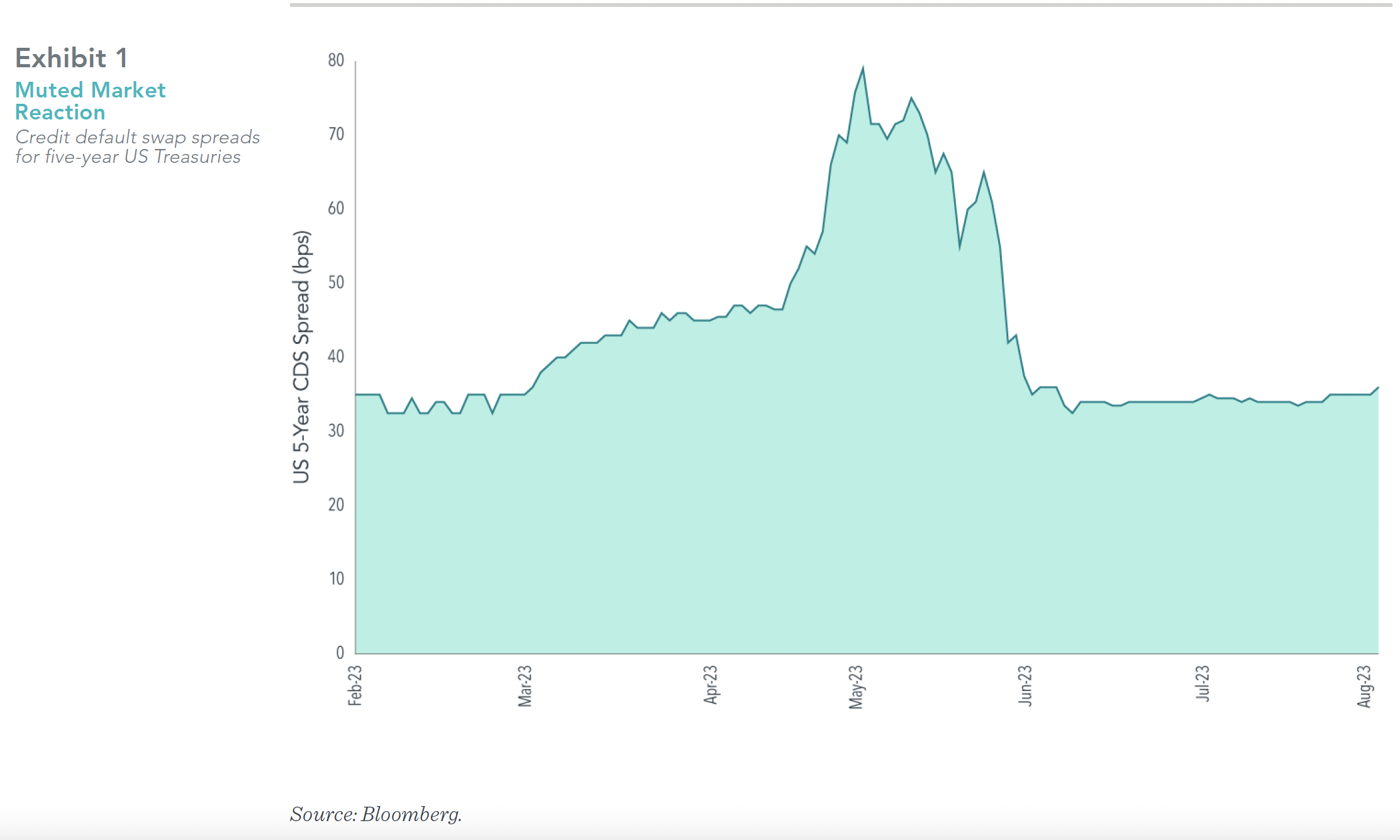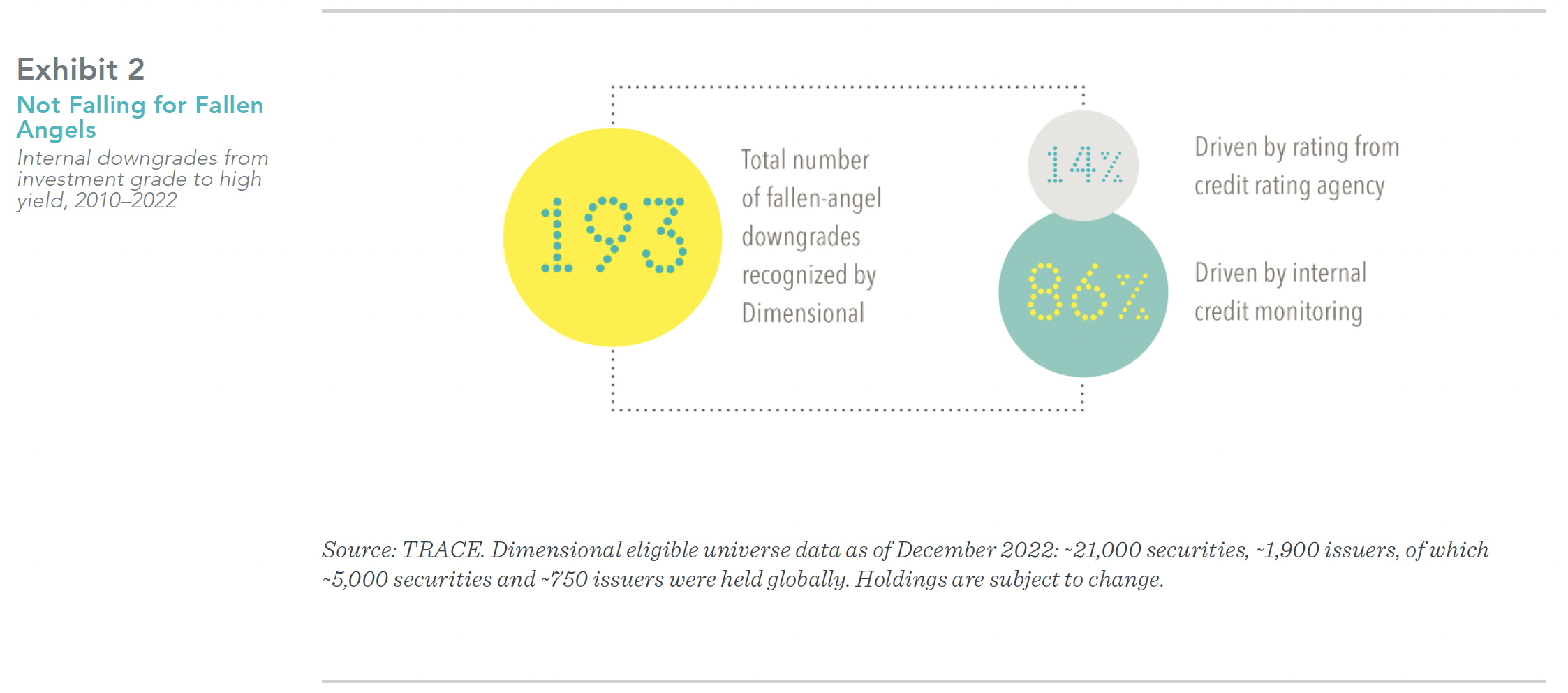KEY TAKEAWAYS
- US debt markets seemed to barely react when Fitch downgraded US government debt.
- Markets are forward-looking and often ratings changes reflect information that is already reflected in market prices.
- Combining market-based data with stated credit ratings from NRSROs may form a more complete and real-time assessment of credit quality.
On August 1, Fitch Ratings downgraded the US government’s credit rating to AA+ from AAA (the best possible rating on a scale from AAA to D).1 Fitch is one of several nationally recognized statistical ratings organizations (NRSROs), along with Standard & Poor’s (S&P) and Moody’s, that publish credit ratings on a wide range of bonds from issuers such as governments and corporations.
In commentary supporting the ratings downgrade, Fitch pointed to several factors, including the debt ceiling debate earlier this year, growing US government debt, and governance concerns.2 Yet in the days immediately following the ratings change announcement, the spread for credit default swaps (CDS) on five-year US Treasuries, which reflects the cost to insure against the US defaulting on its sovereign debt, barely moved (see Exhibit 1). After all, the fiscal and political state of the US government is not exactly a state secret, and while each credit rating agency uses its own methods to assess and issue ratings, they have access to the same historical data and observations that the rest of the market has. Markets are forward-looking and the concerns that played into Fitch’s decision are not new information to most investors.

To assign credit ratings, NRSROs use rating methodologies and analyze market information and issuers’ business or sovereign risk profiles, often relying on information from prior financial statements and forecasts. NRSROs’ ratings process can create a lag between when the market prices in an issuer’s credit change and when an NRSRO changes an issuer’s stated credit rating.
We believe market prices, unlike NRSROs’ ratings, provide a real-time assessment of how market participants view the credit quality of fixed income securities. That’s because participants—and prices—are able to immediately respond to all available information. While stated credit ratings can be informative when assessing an issuer’s creditworthiness, we believe relying on stated ratings alone can lead to using stale credit information. Because of this, Dimensional combines market-based data with stated credit ratings from NRSROs to form a more complete and real-time assessment of an issuer’s credit quality.
To asses whether a bond is trading at a market price that is significantly different from those of its peers with similar stated credit ratings, Dimensional uses, among other things, price information from the Trade Reporting and Compliance Engine (TRACE). If prices in TRACE imply a lower credit quality than the bond’s stated credit rating, Dimensional may assign that bond a lower internal rating.
With a process that monitors live prices, Dimensional can identify bond issuers that may no longer fit within a fixed income strategy’s credit guidelines and potentially avoid such issuers. For instance, as market-based credit information changes, Dimensional uses this information to assign each bond issuer a Dimensional credit rating. In contrast, indexbased fixed income funds rely on a third-party index to determine eligible issuers. As a result, index funds rely on NRSRO ratings to identify which bonds meet their minimum required credit rating for eligibility in the fund. However, Dimensional’s daily credit monitoring enables portfolio managers to use live market prices to assess an issuer’s credit rating rather than rely on lagged NRSRO research.
Even for investors focused on the investment-grade-rated segments of global bond markets, market-informed credit ratings and NRSRO ratings can occasionally differ materially. Between 2010 and 2022, Dimensional downgraded 193 bonds from investment-grade-rated bonds to high-yield-rated, as Exhibit 2 shows. Downgrades from investment grade to high yield are often referred to as “fallen angels.” Of 193 fallen angels identified by Dimensional, 86% were based on Dimensional’s market-based credit monitoring process, whereas only 14% were in reaction to an NRSRO downgrade. The ability to proactively identify issuers whose bonds are trading like lower-rated bonds may enable Dimensional to reduce credit risk in real time more effectively.

Fixed income credit ratings may assist investors in understanding the creditworthiness of different bond issuers. However, Fitch’s recent downgrade of the US government credit rating reinforces that NRSROs’ credit rating changes generally do not provide markets with new information. Rather, NRSROs’ rating changes seem to reflect information already incorporated in market prices. By using live market prices, Dimensional has designed a credit monitoring process that can help us stay one step ahead of NRSROs when assessing issuers’ creditworthiness.
The information in this material is intended for the recipient’s background information and use only. It is provided in good faith and without any warranty or representation as to accuracy or completeness. Information and opinions presented in this material have been obtained or derived from sources believed by Dimensional to be reliable, and Dimensional has reasonable grounds to believe that all factual information herein is true as at the date of this material. It does not constitute investment advice, a recommendation, or an offer of any services or products for sale and is not intended to provide a sufficient basis on which to make an investment decision. Before acting on any information in this document, you should consider whether it is appropriate for your particular circumstances and, if appropriate, seek professional advice. It is the responsibility of any persons wishing to make a purchase to inform themselves of and observe all applicable laws and regulations. Unauthorized reproduction or transmission of this material is strictly prohibited. Dimensional accepts no responsibility for loss arising from the use of the information contained herein.
This material is not directed at any person in any jurisdiction where the availability of this material is prohibited or would subject Dimensional or its products or services to any registration, licensing, or other such legal requirements within the jurisdiction.
“Dimensional” refers to the Dimensional separate but affiliated entities generally, rather than to one particular entity. These entities are Dimensional Fund Advisors LP, Dimensional Fund Advisors Ltd., Dimensional Ireland Limited, DFA Australia Limited, Dimensional Fund Advisors Canada ULC, Dimensional Fund Advisors Pte. Ltd., Dimensional Japan Ltd. and Dimensional Hong Kong Limited. Dimensional Hong Kong Limited is licensed by the Securities and Futures Commission to conduct Type 1 (dealing in securities) regulated activities only and does not provide asset management services.
1. “Fitch Downgrades the United States’ Long-Term Ratings to ‘AA+’ from ‘AAA’; Outlook Stable,” Fitch Ratings, August 1, 2023. Ratings agencies like Fitch Ratings and Standard & Poor’s Corporation (S&P) rate the credit quality of debt issues. The Fitch scale is from AAA to D with intermediate ratings of (+) or (-) offered at each level between AA and CCC.
2. Fitch Ratings.
GLOSSARY
TRACE: The Trade Reporting and Compliance Engine (TRACE) is the Financial Industry Regulatory Authority, Inc. (FINRA) developed vehicle that facilitates the mandatory reporting of over-the-counter secondary market transactions in eligible fixed income securities. All broker/ dealers who are FINRA member firms have an obligation to report transactions in corporate bonds to TRACE under a Securities & Exchange 3 Dimensional Fund Advisors Please see the end of this document for important disclosures. Commission (SEC) approved set of rules.
High-yield bonds: Also known as junk bonds, these bonds have a credit rating below investment grade, and generally pay higher interest rates to compensate for the additional risk.
Investment-grade bonds: A group of bonds with credit ratings ranging from AAA to BBB- that imply a lower default risk and allow companies in the range to offer debt at lower interest rates.
DIMENSIONAL FUND ADVISORS AND TRIAD ADVISORS ARE NOT AFFILIATED.
The information in this document is provided in good faith without any warranty and is intended for the recipient’s background information only. It does not constitute investment advice, recommendation, or an offer of any services or products for sale and is not intended to provide a sufficient basis on which to make an investment decision. It is the responsibility of any persons wishing to make a purchase to inform
themselves of and observe all applicable laws and regulations. Unauthorized copying, reproducing, duplicating, or transmitting of this document are strictly prohibited. Dimensional accepts no responsibility for loss arising from the use of the information contained herein.
“Dimensional” refers to the Dimensional separate but affiliated entities generally, rather than to one particular entity. These entities are Dimensional Fund Advisors LP, Dimensional Fund Advisors Ltd., Dimensional Ireland Limited, DFA Australia Limited, Dimensional Fund Advisors Canada ULC, Dimensional Fund Advisors Pte. Ltd, Dimensional Japan Ltd., and Dimensional Hong Kong Limited. Dimensional Hong Kong Limited is licensed by the Securities and Futures Commission to conduct Type 1 (dealing in securities) regulated activities only and does not provide asset management services.
Dimensional Fund Advisors LP is an investment advisor registered with the Securities and Exchange Commission.
RISKS
Investments involve risks. The investment return and principal value of an investment may fluctuate so that an investor’s shares, when redeemed, may be worth more or less than their original value. Past performance is not a guarantee of future results. There is no guarantee strategies will be successful.
Share this article:
Investor Risk Capacity Survey
Receive Your Risk Number
Take a 5-minute survey that covers topics such as portfolio size, top financial goals, and what you’re willing to risk for potential gains. We’ll use your responses to pinpoint your exact Risk Number to guide our decision-making process.


